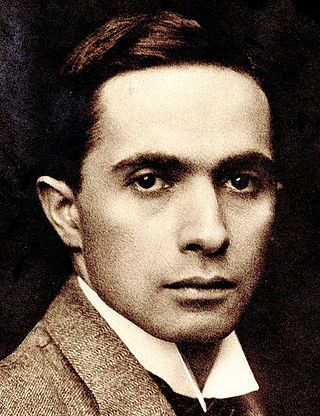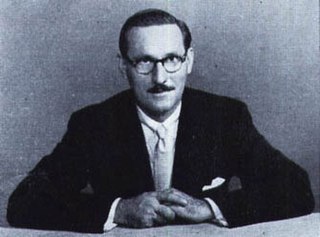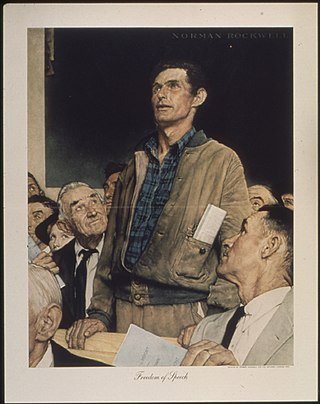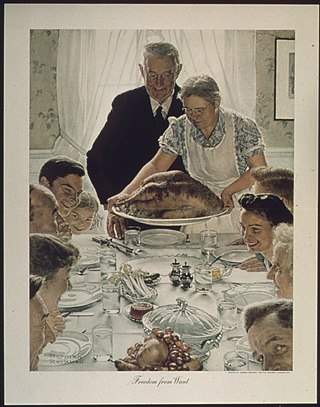Related Research Articles

Norman Percevel Rockwell was an American painter and illustrator. His works have a broad popular appeal in the United States for their reflection of the country's culture. Rockwell is most famous for the cover illustrations of everyday life he created for The Saturday Evening Post magazine over nearly five decades. Among the best-known of Rockwell's works are the Willie Gillis series, Rosie the Riveter, The Problem We All Live With, Saying Grace, and the Four Freedoms series. He is also noted for his 64-year relationship with the Boy Scouts of America (BSA), during which he produced covers for their publication Boys' Life, calendars, and other illustrations. These works include popular images that reflect the Scout Oath and Scout Law such as The Scoutmaster, A Scout Is Reverent, and A Guiding Hand.
Steve Brodner is a satirical illustrator and caricaturist working for publications in the US since the 1970s. He is accepted in the fields of journalism and the graphic arts as a master of the editorial idiom. Currently a regular contributor to GQ, The Nation, Newsweek, The Washington Post, and The Los Angeles Times, Brodner's art journalism has appeared in major magazines and newspapers in the United States, such as Rolling Stone, The New York Times, The New Yorker, Esquire, Time, Playboy, Mother Jones, Harper's, and The Atlantic. His work, first widely seen exposing and attacking Reagan Era scandals, is credited with helping spearhead the 1980s revival of pointed and entertaining graphic commentary in the US. He is currently working on a book about the presidents of the United States.

Joseph Christian Leyendecker was one of the most prominent and financially successful freelance commercial artists in the U.S. He was active between 1895 and 1951 producing drawings and paintings for hundreds of posters, books, advertisements, and magazine covers and stories. He is best known for his 80 covers for Collier's Weekly, 322 covers for The Saturday Evening Post, and advertising illustrations for B. Kuppenheimer men's clothing and Arrow brand shirts and detachable collars. He was one of the few known gay artists working in the early-twentieth century U.S.

Cover art is a type of artwork presented as an illustration or photograph on the outside of a published product such as a book, magazine, newspaper (tabloid), comic book, video game, music album, CD, videotape, DVD, or podcast.
Joseph Csatari is a realist artist who worked with Norman Rockwell. As a boy, Csatari had painstakingly recreated Saturday Evening Post covers that Rockwell had painted. In 1977, shortly before Rockwell died, Csatari was commissioned as the Boy Scouts of America (BSA)'s official artist.

The Society of Illustrators (SoI) is a professional society based in New York City. It was founded in 1901 to promote the art of illustration and, since 1959, has held an annual exhibition.

Al Parker (1906–1985) was an American artist and illustrator.

Kadir Nelson is a Los Angeles–based painter, illustrator, and author who is best known for his paintings often featured on the covers of The New Yorker magazine, and album covers for Michael Jackson and Drake. His work is focused on African-American culture and history. The New York Times describes his work as: "sumptuous, deeply affecting work. Nelson’s paintings are drenched in ambience, and often overt symbolism. He has twice been a Caldecott honor recipient and won the 2020 Caldecott Medal for his book The Undefeated.

John Philip Falter was an American artist best known for his many cover paintings for The Saturday Evening Post.

The National Museum of American Illustration (NMAI), founded in 1998, is the first national museum to be devoted exclusively to American illustration artwork. The NMAI is located in the Vernon Court mansion on Bellevue Avenue in Newport, Rhode Island. The museum's collection contains over 2,000 original works by noted American illustrators such as Norman Rockwell, Maxfield Parrish, J. C. Leyendecker, N.C. Wyeth, and others.
Anita E. Kunz, OC, DFA, RCA is a Canadian-born artist and illustrator. She was the first woman and first Canadian to have a solo exhibit at the Library of Congress in Washington, D.C.
Sterling Clinton Hundley is an American illustrator and painter. He is also the Founder of Legendeer, a community focused on embedding artists back into the world. He is a professor in the Department of Communication Arts at Virginia Commonwealth University. He is also one of five core art instructors at the Illustration Academy, held every summer in Kansas City, Missouri.

Willie Gillis, Jr. is a fictional character created by Norman Rockwell for a series of World War II paintings that appeared on the covers of 11 issues of The Saturday Evening Post between 1941 and 1946. Gillis was an everyman with the rank of private whose career was tracked on the cover of the Post from induction through discharge without being depicted in battle. He and his girlfriend were modeled by two of Rockwell's acquaintances.

The Four Freedoms is a series of four oil paintings made in 1943 by the American artist Norman Rockwell. The paintings—Freedom of Speech, Freedom of Worship, Freedom from Want, and Freedom from Fear—are each approximately 45.75 by 35.5 inches, and are now in the Norman Rockwell Museum in Stockbridge, Massachusetts. The four freedoms refer to President Franklin D. Roosevelt's January 1941 Four Freedoms State of the Union address, in which he identified essential human rights that should be universally protected. The theme was incorporated into the Atlantic Charter, and became part of the Charter of the United Nations. The paintings were reproduced in The Saturday Evening Post over four consecutive weeks in 1943, alongside essays by prominent thinkers of the day. They became the highlight of a touring exhibition sponsored by The Post and the U.S. Department of the Treasury. The exhibition and accompanying sales drives of war bonds raised over $132 million.

Freedom from Want, also known as The Thanksgiving Picture or I'll Be Home for Christmas, is the third of the Four Freedoms series of four oil paintings by American artist Norman Rockwell. The works were inspired by United States President Franklin D. Roosevelt's 1941 State of the Union Address, known as Four Freedoms.
Tim O'Brien is an American artist who works in a realistic style. His illustrations have appeared on the covers and interior pages of magazines such as Time, Rolling Stone, GQ, Esquire, National Geographic, Der Spiegel, and others. His illustrations are also used by the US Postal Service for postage stamps.
Gregory Manchess is an American illustrator from Kentucky. His illustrations have appeared in magazines, digital murals, illustrated movie posters, advertising campaigns, and book covers, including sixty covers for Louis L’Amour. His work has appeared on Major League Baseball World Series Programs, Time, Newsweek, The Atlantic Monthly, Playboy, Smithsonian and National Geographic. His style includes broad brush strokes and excellent figure work.

Drew Struzan is an American artist, illustrator and cover designer. He is known for his more than 150 movie posters, which include The Shawshank Redemption, Blade Runner, E.T. the Extra-Terrestrial, as well as films in the Indiana Jones, Back to the Future, and Star Wars film series. He has also painted album covers, collectibles, and book covers.

Edmund Archer (1904–1986) was an American artist best known for his portraits of African Americans. He was born in Richmond, Virginia, to parents who were both culturally and socially prominent in that city. Having taken an early interest in painting, he took art classes continually from childhood into his adult years. His long career included periods spent in Richmond, Paris, New York, and Washington, D.C. In addition to painting, he served as an assistant curator at the Whitney Museum of American Art and an instructor at the Corcoran School of Art. His portrait style tended toward a poster-like flatness early in his career and later toward a more traditional modeled style. He painted with a high degree of realism throughout his career and rarely experimented with any degree of abstraction. Galleries and museums gave him frequent exhibitions and both individual and institutional collectors provided him with income from sales. In 1938, a critic said he was then considered to be "one of the best of the young artists in the United States". A few months later, another critic credited his success to hard work: "Edmund Minor Archer has had advantages. His success story is no Horatio Alger tale. It is a story of an earnest and deeply talented artist who has worked and studied in humility and devotion, and has early reached the top, hard step by hard step".
References
- ↑ Nelson, Bill – Library of Congress Name Authority Files
- ↑ Norman Rockwell Museum Featured Illustrators, 1993–2008
- ↑ "Artist Bill Nelson back in Richmond after crafting a global career", Richmond Times-Dispatch, 5 Dec 2015
- ↑ Art of the Stamp: Bill Nelson
- ↑ "Strike up the Big Bands, The Washington Post , September 6, 1996
- ↑ "Artist Bill Nelson back in Richmond after crafting a global career", Richmond Times-Dispatch, 5 Dec 2015